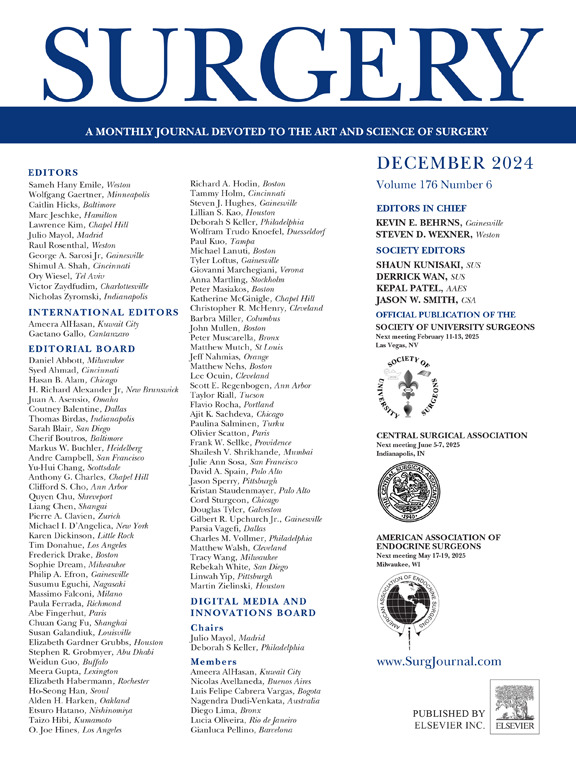保肾手术在肾外伤中的作用:一项全国性分析
IF 3.2
2区 医学
Q1 SURGERY
引用次数: 0
摘要
背景:尽管肾外伤通常采用非手术治疗,但在一些患者中,手术干预可能是必要的。在手术治疗中,选择全肾切除术还是保留肾脏的基本原理尚不清楚。在这项研究中,我们旨在确定保肾手术在肾外伤治疗中的作用。方法使用2017-2021年国家创伤数据库,回顾性评估全肾切除术或保肾手术患者的临床特征和结局。我们对采用保肾手术的患者进行了logistic回归,并评估了两组患者住院并发症的风险。结果52212例肾损伤患者中,分别有1756例(3.4%)行全肾切除术和794例(1.5%)行保肾手术。穿透性损伤患者更有可能接受保肾手术(优势比3.18;95%置信区间。2.34-4.31, P <;措施)。收缩压≥90 mm Hg的患者首选全肾切除术(优势比0.61;95%置信区间,0.47-0.79,P <;.001),格拉斯哥昏迷量表<;9(优势比0.51;95%置信区间,0.37-0.70,P <;.001)或高度肾损伤(优势比0.41;95%置信区间,0.33-0.52,P <;措施)。保肾手术与术后尿漏手术风险增加相关(优势比1.40;95%可信区间,1.06-1.85,P = 0.019),但需要血液透析的概率较低(优势比,0.32;95%可信区间,0.14-0.72,P = 0.006)或发生急性肾损伤(优势比,0.49;95%置信区间为0.32-0.76,P = .001)。结论稳定的穿透性创伤及轻度损伤患者首选保肾手术。与全肾切除术相比,它需要进行尿漏手术的风险更大,但急性肾损伤和血液透析的风险降低。本文章由计算机程序翻译,如有差异,请以英文原文为准。
The role of kidney-preserving surgery in renal trauma: A nationwide analysis
Background
Although renal trauma is commonly managed nonoperatively, surgical intervention may be necessary in some patients. Within operative management, the rationale for choosing between total nephrectomy and kidney-preserving approaches remains unclear. In this study, we aimed to define the role of kidney-preserving surgery within renal trauma management.
Methods
Using the National Trauma Data Bank 2017–2021, we retrospectively evaluated clinical characteristics and outcomes of patients who underwent total nephrectomy or kidney-preserving surgery. We performed logistic regression for the use of kidney-preserving surgery and to assess the risk of hospital complications between the 2 cohorts.
Results
Of 52,212 patients with renal injury, 1,756 (3.4%) and 794 (1.5%) underwent total nephrectomy and kidney-preserving surgery, respectively. Patients with penetrating injuries were more likely to undergo kidney-preserving surgery (odds ratio, 3.18; 95% confidence interval. 2.34–4.31, P < .001). Total nephrectomy was preferred for patients with admission systolic blood pressure <90 mm Hg (odds ratio, 0.61; 95% confidence interval, 0.47–0.79, P < .001), Glasgow Coma Scale <9 (odds ratio, 0.51; 95% confidence interval, 0.37–0.70, P < .001), or high-grade renal injuries (odds ratio, 0.41; 95% confidence interval, 0.33–0.52, P < .001). Kidney-preserving surgery was associated with a greater risk for postoperative urine leakage procedures (odds ratio, 1.40; 95% confidence interval, 1.06–1.85, P = .019) but a lower probability of requiring hemodialysis (odds ratio, 0.32; 95% confidence interval, 0.14–0.72, P = .006) or developing acute kidney injury (odds ratio, 0.49; 95% confidence interval, 0.32–0.76, P = .001).
Conclusion
Kidney-preserving surgery is preferred for stable patients with penetrating trauma and lower-grade injuries. It carries a greater risk of requiring procedures for urine leakage but a decreased risk for acute kidney injury and the need for hemodialysis when compared to total nephrectomy.
求助全文
通过发布文献求助,成功后即可免费获取论文全文。
去求助
来源期刊

Surgery
医学-外科
CiteScore
5.40
自引率
5.30%
发文量
687
审稿时长
64 days
期刊介绍:
For 66 years, Surgery has published practical, authoritative information about procedures, clinical advances, and major trends shaping general surgery. Each issue features original scientific contributions and clinical reports. Peer-reviewed articles cover topics in oncology, trauma, gastrointestinal, vascular, and transplantation surgery. The journal also publishes papers from the meetings of its sponsoring societies, the Society of University Surgeons, the Central Surgical Association, and the American Association of Endocrine Surgeons.
 求助内容:
求助内容: 应助结果提醒方式:
应助结果提醒方式:


